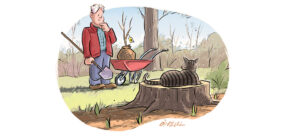
Writing on the Edge
Short stories that stick
By Anne Blythe
Joanna Pearson, a psychiatrist in the Chapel Hill area, describes herself as a “lapsed poet” on the jacket of her new short story collection, titled Now You Know It All.
Yet, in the 11 stories that plumb the depths of the hearts and minds of a variety of flawed but intriguing characters, it’s clear that Pearson’s poetic touch is not on hiatus. The author deftly describes settings, backstories and eerie omens as the narrators of her mini-mysteries move toward precipices that will forever change their lives.
These stories can be dark, tempting readers to turn their eyes away from characters whose hard-living and messy circumstances have pushed them to a point where they struggle mentally with what is and isn’t real.
It’s difficult to read about James, the foster child (also known as the Devil Boy), the therapist Miss Beth Ann, and her boyfriend in “The Films of Roman Polanski” and not be disquieted by the troubling, manipulative behavior on display in that story. In “Mr. Forble,” you might get creeped out as you read about the disturbed 13-year-old boy who tries to sic the miscreant from an internet hoax on his birthday party guests.
Other characters we meet in Now You Know It All include two sisters at their grandmother’s rural Burke County home who hear about a boy tied up in the barn next door; a pregnant woman in her 40s reliving a previous brutal bout of postpartum depression; and a waitress/bartender wooed away from her small Southern town by a socialite eerily similar to Ghislaine Maxwell.
Pearson builds compassion for her storytellers as they teeter toward their ominous misfortunes, while hooking readers with her descriptive writing.
“There were ruins and fountains and a fury of beeping horns,” Pearson writes in “Rome,” the opener of the book. “Naked putti lounging fatly in marble. Gorgeous long-armed women in skirts and strappy sandals, and young men hanging out of their cars in mirrored glasses. Old men in storefronts arranged cheeses and sausages tenderly, as if they were tucking in sleeping infants while chattering tour groups trailed guides holding red umbrellas, and honeymooners licked perfect gelatos.”
That’s how we meet Lindsay, an American college student exploring Rome with her friend Paul. They’re sick of each other, and as it is with each story in the collection, Pearson does not seduce her readers with an ordinary tale about a young couple exploring their feelings for each other as they travel together in a foreign land. Expect the unexpected.
“We were finally seeing all the things — beautiful, famous things we’d waited all our young lives to see — but we couldn’t appreciate any of it any longer,” Lindsay said.
Then comes the plot twist.
After an unanticipated night of romance with Paul — and him spending the next day worrying about it — Lindsay sets out on her own for a day trip to the Tivoli ruins, leaving her traveling partner alone in bed in the hostel. Along the way she meets the Gooleys, a “seemingly wholesome family” of five blonde-haired girls, a Pentecostal father and mother who she believed to be pregnant.
Not only does Lindsay come to realize the “wholesomeness” of the family she was touring the ruins with might be more of the “slippery quality” that sometimes accompanies such carefully crafted images, she also questions who she really is.
Pearson’s stories rarely conclude with a clean-cut resolution to the many mysteries posed, leaving a sense of uneasiness that gives a nod toward the tumult of our times.
In “The Field Glasses,” Pearson opens with the line: “For weeks my sister Clara had been warning me that there was something in the woods that wanted to eat the children.”
And she closes it with: “There was another call, a different animal this time, joining in mournfully with the first, their voices rising in a strange duet, and I determined it must be two dogs, something wounded and wild in their voices. Through the dark of the trees, I imagined or heard the crack of branches. Something hungry out there. I waited for a figure — my sister, a deer, some other animal — to emerge.”
That’s it. The end of the story. In Pearson’s world, the uncertainty lingers, leaving readers to long ponder not only what’s lurking in the woods but what truly lurks in the minds of the narrators. She shows us how the power of suggestion and expectation can shape her characters’ narratives, as well as our own.
We never really know everything they’re thinking or how what’s roiling below the surface is going to lead to new discoveries.
Pearson’s stories might be short, but they have a long-lasting impression while craftily making you think about life’s mysteries. PS
Anne Blythe has been a reporter in North Carolina for more than three decades. She has covered city halls, higher education, the courts, crime, hurricanes, ice storms, droughts, floods, college sports, health care and many wonderful characters who make this state such an interesting place.





